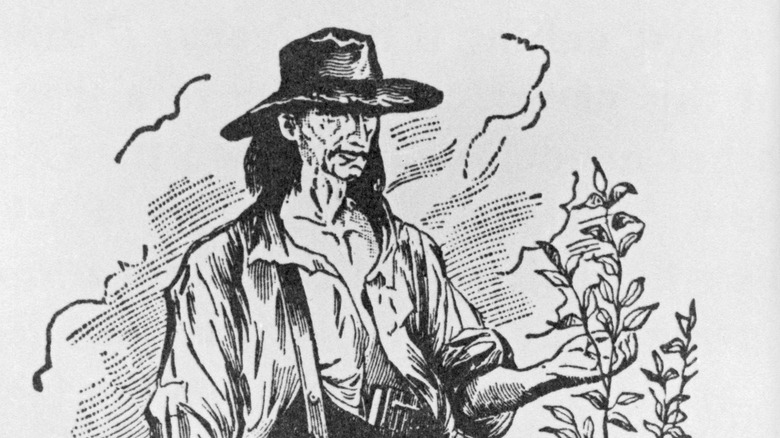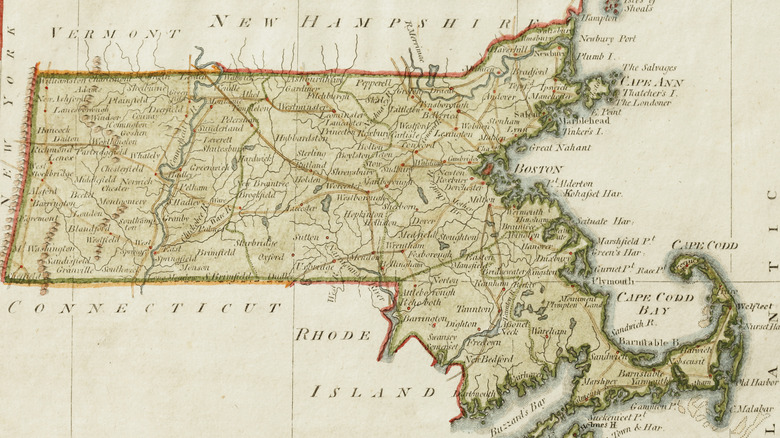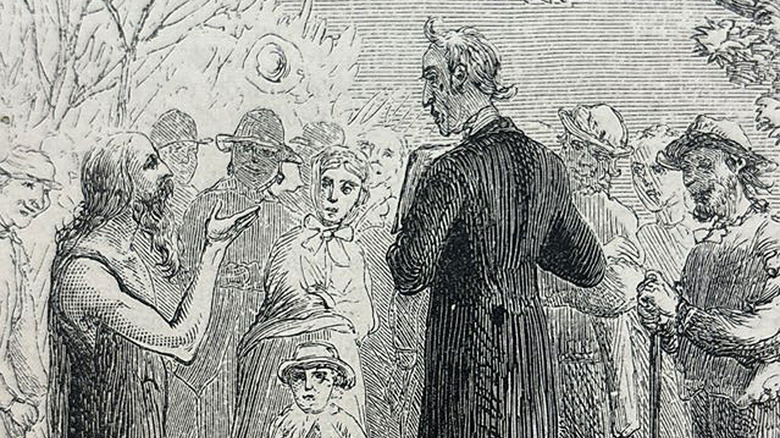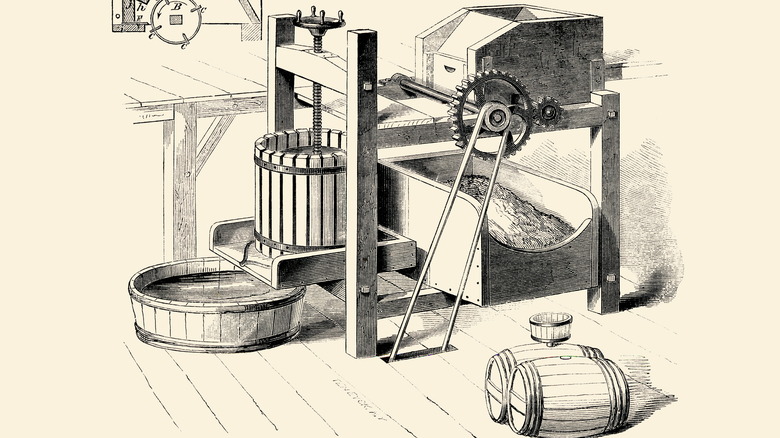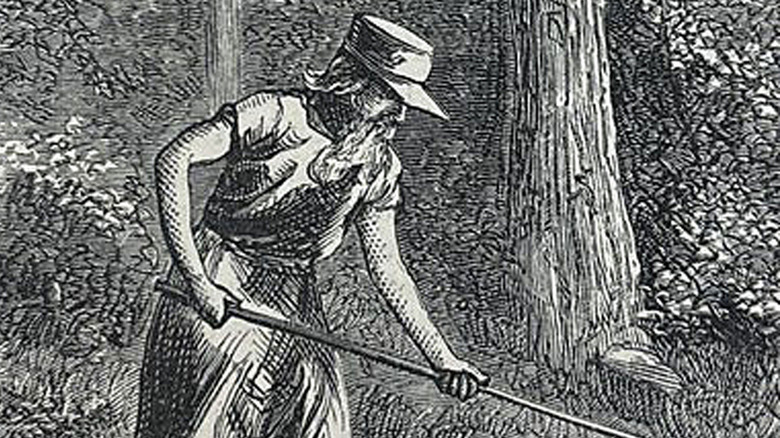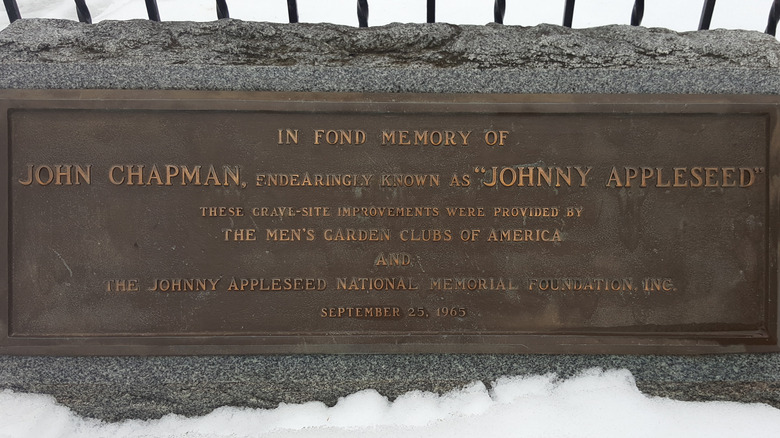The Hidden Truth About Johnny Appleseed
In February 1846, the Magazine of Horticulture included an article titled "Johnny Appleseed" describing an itinerant orchardist who traveled around the Midwest planting apple seeds. He was regarded by his fellow settlers with "a degree of almost superstitious admiration." This was the birth in print of an American folk hero. And like other legendary figures such as Davy Crockett or John Henry, as their stature grew over time, so did America's tall tales about them.
In the case of Johnny Appleseed, whose real name was John Chapman, some of the more surprising details of his story are true: He wore rags and often went barefoot, traveled extensively, lived an aesthetic life, and planted apple orchards across three states. But beyond this, there's much more than the Walt Disney version. Chapman was an astute businessman whose apples were used for making alcohol, not for eating. He practiced a fringe offshoot of Christianity, and his popular image was cleaned up by the apple industry under the gun from the temperance movement.
He was from Massachusetts
While Johnny Appleseed is best known for his travels through Pennsylvania, Ohio, and Indiana, he was born in Leominster, Massachusetts, in September 1774. Chapman's mother, Elizabeth, died when he was still a small child. His father, Nathaniel, was a farmer who fought in the Revolutionary War at the Battle of Bunker Hill — the first major battle of the conflict — and later served under General George Washington.
After the war, Chapman's father remarried, and in 1804, he moved the family to Ohio, where John became an apprentice orchardist. By 1817, he was already beginning his lifelong habit of planting apple orchards as he traveled from place to place. Dr. Willam Bushnell, an Ohio physician, became friends with Chapman. "He was a small, wiry man, with thin lips, dark face and long dark hair," the doctor told The Buffalo News in 1888. "His eyes were black and sharp and piercing." Chapman's visits always included a religious element. He would pass along books, tracts, and preach about Swedenborgianism, the religion he was a devout believer in.
Johnny Appleseed the evangelist
John Chapman was a follower of the teachings of Emanuel Swedenborg (1688-1772). The Swedish mystic, scientist, and theologian held many beliefs, including love being the essential message of the Bible, the importance of charitable works, and the idea that salvation is progressive. After his death, Swedenborg's followers founded the Church of the New Jerusalem or New Church, which spread his message to the U.S., although it didn't have a large following.
Besides Chapman's religious beliefs (or perhaps inspired by them), he was a vegetarian, had a deep love of all living creatures, and never carried a weapon for self-defense as he rambled through the wilderness. His clothing was humble in the extreme, ragged at best, and he sometimes wore a rough sack with holes cut in it for his arms and head. He rarely wore shoes. Still, Chapman's religious beliefs didn't stop him from planting apple orchards that were almost exclusively used to produce alcohol, nor did it preclude his establishment of a multi-state business and real-estate empire of sorts.
Spitters not eaters
The popular image of Johnny Appleseed today would have you believe he was growing shiny, sweet, and tasty McIntosh-type apples, but this couldn't be further from the truth. John Chapman's apples were called cider apples, or spitters, because of their tart and bitter taste from the tannins found inside. Johnny Appleseed's fruits were for hard cider, not eating. In a time when water and milk harbored a multitude of bacteria and other potential hazards, frontier settlers mainly drank alcohol, from childhood up. It was considered a part of a proper diet.
Apples grown from seed never produce the same fruit as its parents, as Chapman well knew. Typically, for eating apples, orchardists graft a cutting from the parent tree onto rootstock. As he planted his orchards across the frontier, Chapman laid the groundwork for people to turn his apples into alcohol. But there was another aspect to Chapman's preference for growing apple trees from seed, and it revolved around business.
Johnny Appleseed the landowning business man
The Disney version of Johnny Appleseed planting seeds at random for no other reason than to help his fellow pioneers isn't true. John Chapman had a plan and a turn of mind for business. While he did often give seeds and trees away, he also sold them and owned many of the parcels where he grew his apples. At the time, pioneers could claim 100 acres of wilderness land if they planted at least 50 apple trees within three years.
Chapman had a knack for planting his orchards on land good for homesteading as he traveled west ahead of the pack. When settlers did arrive, he'd be there to sell the plantations. In some instances, he'd hire someone to maintain the ones he kept. By 1845, the year he died, he owned about 1,200 acres of land and had a string of nurseries in three states. Another smart move on his part was his low overhead — he collected his apple seeds for free from cider mills.
The popular press (and Prohibition) shaped Johnny Appleseed's image
As early as the 1820s, John Chapman's nickname of Johnny Appleseed had already taken root. His unique appearance, gentle demeanor, and unusual habits helped make him a regional folk hero while he was alive. After his death in Fort Wayne, Indiana at age 71, Johnny Appleseed became an American folk hero thanks to a national press that often focused on his strength and fortitude. An 1871 article about Chapman in Harper's New Monthly, a hugely popular American magazine, helped shape his image as the saintly oddball we know today and introduced him to the country at large.
The common misconception about the kinds of apples Chapman grew came from the apple industry. As the temperance movement against alcohol grew in the early 1900s (eventually achieving Prohibition), apple growers attempted to downplay the connection of their fruits with hard cider. By the mid-20th century, Johnny Appleseed's ties to alcohol production, his business acumen, and his Swedenborgian beliefs had been all but erased, helped along by Walt Disney's 1948 short animated film about the folk hero. John Chapman had been displaced by the legend of Johnny Appleseed.
